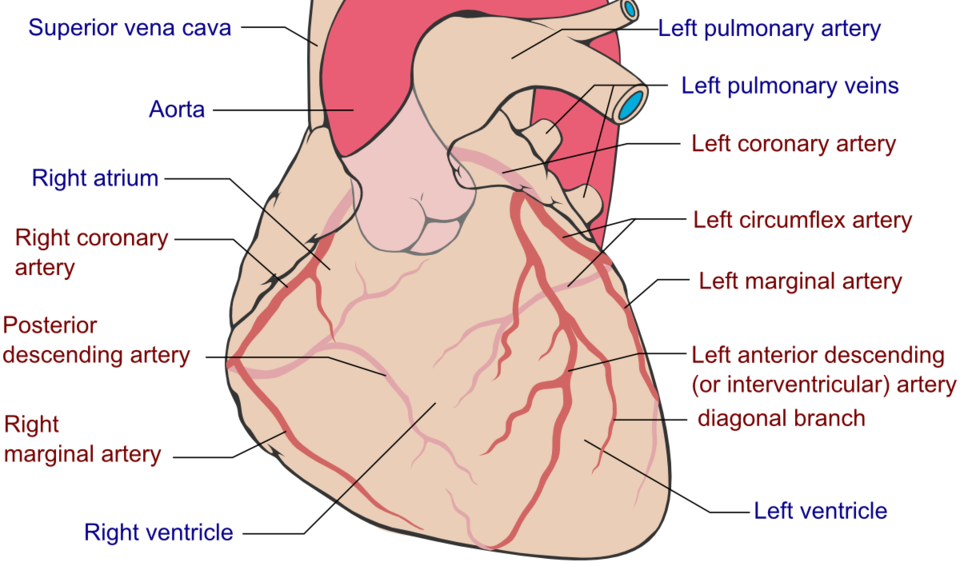Cardiology > Pulmonary Stenosis
Pulmonary Stenosis
Empty
1. Knuuti J, Wijns W, Saraste A, Capodanno D, Barbato E, Funck-Brentano C, et al. 2019 ESC Guidelines for the diagnosis and management of chronic coronary syndromes. Eur Heart J. 2020;41(3):407-477.
PMID: 31504439
DOI: https://doi.org/10.1093/eurheartj/ehz425
2. Fihn SD, Gardin JM, Abrams J, Berra K, Blankenship JC, Dallas AP, et al. 2012 ACCF/AHA/ACP/AATS/PCNA/SCAI/STS guideline for the diagnosis and management of patients with stable ischemic heart disease. J Am Coll Cardiol. 2012;60(24):e44-e164.
PMID: 23182125
DOI: https://doi.org/10.1016/j.jacc.2012.07.013
3. Khan MA, Hashim MJ, Mustafa H, Baniyas MY, Al Suwaidi SKBM, AlKatheeri R, et al. Global epidemiology of ischemic heart disease: Results from the Global Burden of Disease Study. Cureus. 2020;12(7):e9349.
PMID: 32742886
DOI: 10.7759/cureus.9349
4. Ibanez B, James S, Agewall S, Antunes MJ, Bucciarelli-Ducci C, Bueno H, et al. 2017 ESC Guidelines for the management of acute myocardial infarction in patients presenting with ST-segment elevation. Eur Heart J. 2018;39(2):119-177.
PMID: 28886621
DOI: https://doi.org/10.1093/eurheartj/ehx393
5. Amsterdam EA, Wenger NK, Brindis RG, Casey DE Jr, Ganiats TG, Holmes DR Jr, et al. 2014 AHA/ACC guideline for the management of patients with non–ST-elevation acute coronary syndromes. J Am Coll Cardiol. 2014;64(24):e139-e228.
PMID: 25260716
DOI: https://doi.org/10.1016/j.jacc.2014.09.017
Background
Pulmonary stenosis (PS) is a narrowing of the right ventricular outflow tract (RVOT) at the level of the pulmonary valve or just above or below it, impeding blood flow from the right ventricle (RV) to the pulmonary artery. This obstruction increases RV pressure, causes hypertrophy, and may lead to right-sided heart failure if severe and untreated.
II) Classification or Types
By Anatomic Level:
- Valvular (most common): Fusion or thickening of pulmonary valve leaflets.
- Subvalvular (infundibular): Hypertrophy or fibromuscular narrowing below the valve.
- Supravalvular: Narrowing of the main pulmonary artery above the valve.
- Branch pulmonary artery stenosis: Involves right or left pulmonary artery branches.
By Onset and Progression:
- Congenital PS: Most common, often isolated or part of complex congenital syndromes (e.g., Tetralogy of Fallot, Noonan syndrome).
- Acquired PS: Rare, may result from carcinoid syndrome, rheumatic fever, or prior surgical repair.
By Severity (via echocardiographic Doppler gradient):
- Mild: Peak gradient <36 mmHg
- Moderate: 36–64 mmHg
- Severe: >64 mmHg
III) Epidemiology
- Age: Primarily a pediatric condition; diagnosed in infancy or childhood.
- Sex: Slight female predominance in isolated congenital PS.
- Geography: Global incidence; increased in regions with high rates of congenital heart disease.
- Comorbidities: Associated with congenital syndromes (e.g., Noonan syndrome, Williams syndrome), other congenital heart defects, and maternal rubella infection during pregnancy.
Etiology
I) Causes of Pulmonary Stenosis:
Congenital Valve Malformation (most common): Dysplastic, bicuspid, or domed pulmonary valve.
Noonan Syndrome: Genetic disorder often associated with dysplastic pulmonary valves.
Carcinoid Heart Disease: Serotonin-induced fibrosis affecting right-sided valves.
Rheumatic Heart Disease: Rare cause of acquired PS.
Post-Surgical or Post-Interventional Scar Tissue
II) Risk Factors
Family history of congenital heart disease
Genetic syndromes (e.g., Noonan, Alagille, Williams)
Maternal rubella or other teratogens during pregnancy
Carcinoid syndrome or metastatic tumors
Previous cardiac surgery or catheter-based interventions
Clinical Presentation
I) History (Symptoms)
Mild PS: Often asymptomatic, discovered incidentally on auscultation or echocardiography.
Moderate to Severe PS:
- Exertional dyspnea or fatigue
- Chest pain (rare)
- Syncope or presyncope on exertion
- Signs of right heart failure (edema, abdominal bloating)
Infants/Neonates with Critical PS: - Cyanosis due to right-to-left shunting via patent foramen ovale or atrial septal defect
- Poor feeding, lethargy
II) Physical Exam (Signs)
Vital Signs:
- Often normal in mild cases
- Hypoxemia or cyanosis in critical PS
Cardiac Exam:
- Harsh systolic ejection murmur at left upper sternal border
- Murmur intensity correlates with severity (louder in moderate cases, softer if severe with poor flow)
- Systolic ejection click (valvular PS), decreases with inspiration
- Right ventricular heave
- Widely split second heart sound (delayed pulmonary closure)
Peripheral Signs:
- Jugular venous distension
- Peripheral edema (if RV failure develops)
Abdomen
- Hepatomegaly
Differential Diagnosis (DDx)
Atrial septal defect (ASD)
Tetralogy of Fallot
Pulmonary atresia
Tricuspid stenosis
Right ventricular outflow tract obstruction from other causes
Heart failure with preserved EF
Congenital syndromes with complex cardiac anomalies
Diagnostic Tests
Initial Tests
Transthoracic Echocardiogram (TTE):
- Diagnostic test of choice
- Measures pressure gradient, valve morphology, RV size/thickness
- Doppler flow across pulmonary valve
Electrocardiogram (ECG):
- Right ventricular hypertrophy
- Right axis deviation
- Possible right atrial enlargement
Chest X-ray:
- Prominent main pulmonary artery segment (post-stenotic dilation)
- Normal or enlarged heart silhouette
- Clear lung fields unless heart failure present
Cardiac MRI/CT:
- Useful for detailed anatomy in complex cases
- Evaluates branch pulmonary arteries and RV function
Cardiac Catheterization:
- Confirms pressure gradient
- Useful before surgical or interventional therapy
Treatment
I) Medical Management
Asymptomatic Mild to Moderate PS:
- Observation with periodic echocardiographic monitoring
- No pharmacologic treatment needed if hemodynamically stable
Right Heart Failure (in advanced cases):
- Diuretics for volume overload
- Oxygen if hypoxemic
Critical PS in Neonates:
- Prostaglandin E1 to maintain ductus arteriosus patency
- Urgent balloon valvotomy
II) Interventional/Surgical
Balloon Pulmonary Valvuloplasty:
- First-line treatment for isolated valvular PS (especially in children)
- High success rate; avoids open surgery
Surgical Repair:
- Indicated in dysplastic valves not amenable to balloon dilation
- Also for supravalvular, subvalvular, or branch PS
- May require valve replacement if severe or calcified
Patient Education, Screening, Vaccines
- Importance of regular follow-up with echocardiograms
- Awareness of exercise limitations in moderate to severe PS
- Educate on signs of right heart failure (edema, fatigue, dyspnea)
- Endocarditis prophylaxis not routinely indicated unless prior endocarditis or prosthetic material
- Encourage good dental hygiene
Vaccinations:
- Influenza (annually)
- Pneumococcal vaccine
- COVID-19 vaccine
- RSV prophylaxis in infants with significant congenital heart disease
Consults/Referrals
- Pediatric Cardiology: All children with congenital PS
- Adult Congenital Heart Disease (ACHD) Specialist: For adolescents/adults with repaired or unrepaired PS
- Cardiothoracic Surgery: For surgical intervention or complex congenital anatomy
- Genetics: If syndromic features present (e.g., Noonan syndrome)
- Pulmonology: If secondary pulmonary disease suspected
Follow-Up
- Mild PS: Echocardiogram every 3–5 years
- Moderate PS: Annual to biennial echocardiograms
- Severe or Repaired PS: Every 6–12 months, depending on symptoms and RV function
- Monitor for:
- RV hypertrophy or dysfunction
- Progression of stenosis
- Development of arrhythmias
- Lifelong surveillance for those with congenital PS, even after intervention
Stay on top of medicine. Get connected. Crush the boards.
HMD is a beacon of medical education, committed to forging a global network of physicians, medical students, and allied healthcare professionals.

